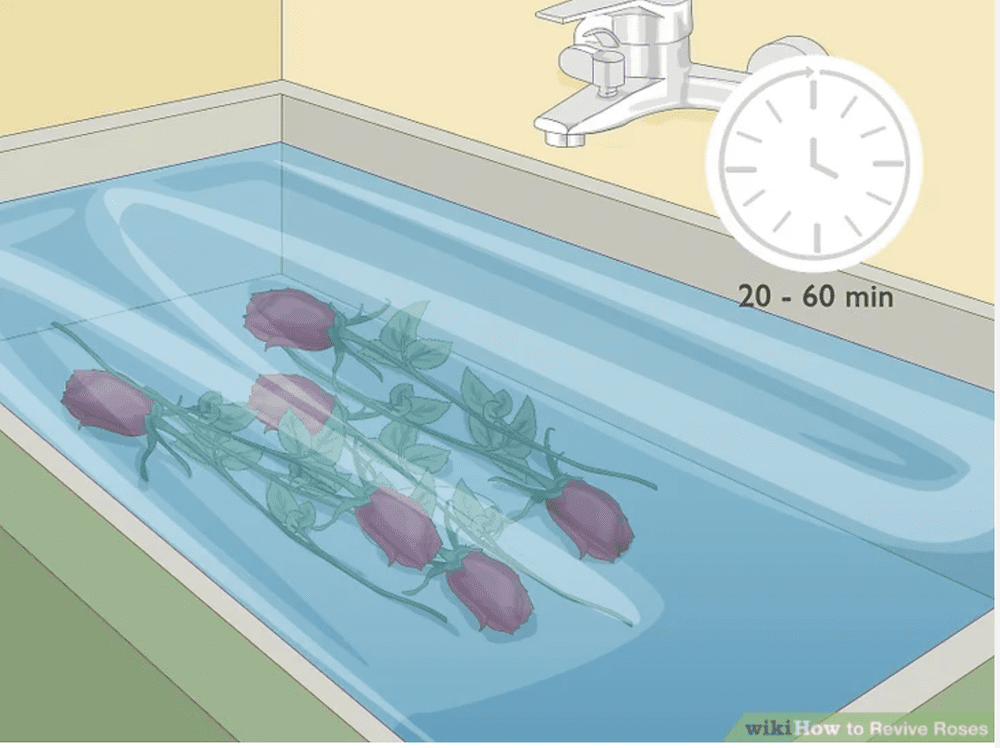Tips to Revive Your Drooping Wilting Vase Roses
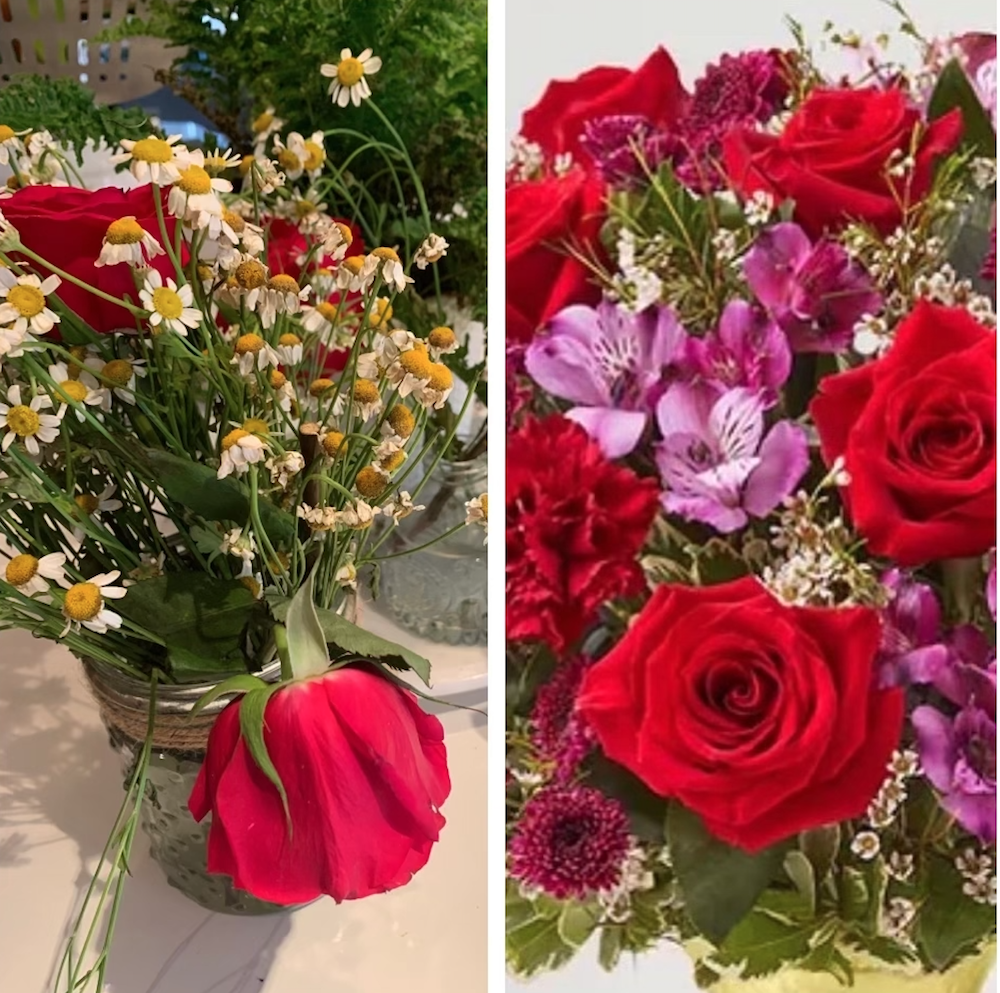
It can be a bummer to see your beautiful roses wilt and droop. They typically start to show signs of decay after a few days, but there are a few things you can do to perk them up again. Soaking cut roses in a warm water bath, feeding them, and doing regular maintenance will keep roses looking fresh and beautiful for longer.
1) Fill a clean bathtub or sink with enough warm water to cover the roses. Stop up the drain and turn on the warm water tap to fill a sink or bathtub with enough water to cover the roses. The temperature of the water should be lukewarm or a little hotter.
- About 5 inches (13 cm) to 6 inches (15 cm) of water should do it.
- Make sure your bathtub or sink is free of grime and soaps before you fill it with water for the rose bath.

2) Recut the stems at an angle under warm running water. Turn on the faucet until you have a stream of warm water. Position the stem under the stream and use garden shears to slice off at least 1 inch (2.5 cm) of the stem at a diagonal angle.
- The diagonal angle allows the stem to take in more water.
- Cutting the stems under warm running water prevents air bubbles from stopping up the stem’s tissues responsible for taking in water.
- If you’re bathing the roses in the sink, use a different sink to recut them or, if possible, use the other side of the sink

3) Submerge the roses in the warm water bath for about 20 to 60 minutes. Place each stem horizontally into the bath and push them down so that each rose (the heads included) is fully submerged in the water.
- This may not revive your roses if they’re extremely wilted, especially if the neck shows any signs of shriveling. The idea is that the roses will absorb enough water to be revived – if they can be.
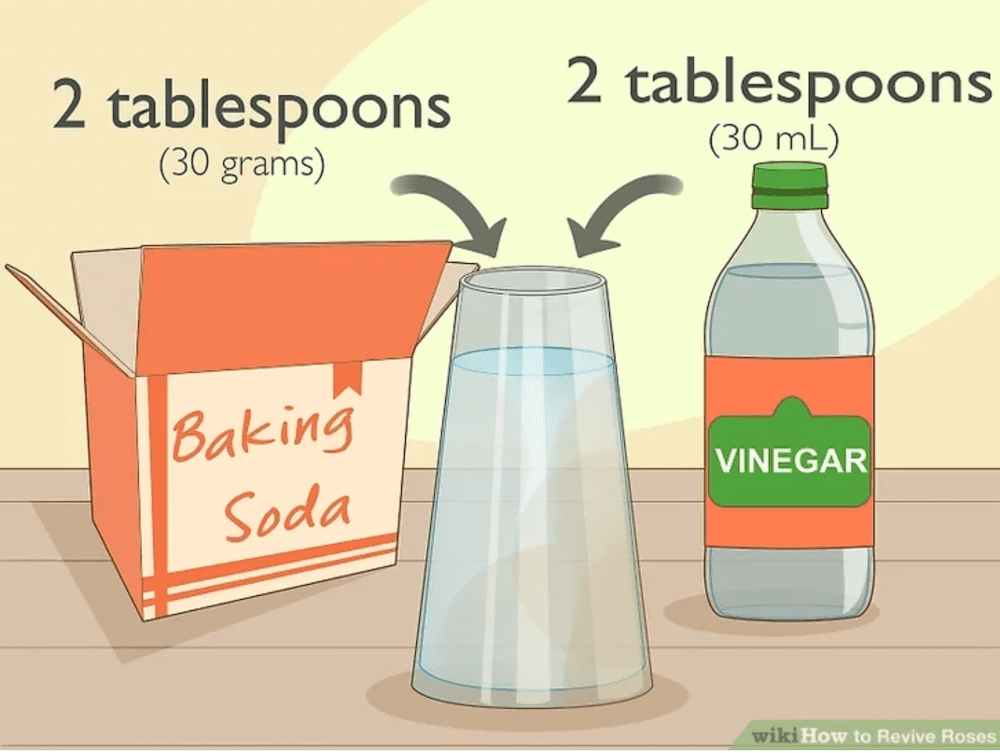
4) Clean the vase with a mixture of vinegar and baking soda. Pour out the soiled water and then refill it to just above the waterline with tap water, 2 tablespoons (29.6 ml) (30 grams) of baking soda, and 2 tablespoons (30 mL) of white vinegar. Let it fizz and settle for about 30 minutes before wiping away any film with a cloth or bottle brush. Thoroughly rinse the vase before you use it again.
- It’s important to keep the vase clean so any bacteria doesn’t block the stems from taking in water.
- If necessary, pour in about 1/4 cup (32 grams) of uncooked rice in the vase to help scrub down the sides.

5) Fill the clean vase 3/4 full with warm water and flower preservative. Fill the vase with tap water and then pour in a packet of flower preservatives. If you bought your roses or had them delivered, they probably came with a packet of flower food. If you need more, you can buy flower preservatives (AKA flower feed or flower food) at any floral shop or grocery store that has a nursery.
- The roses can take in warm water better than cold water.
- You can also make your own flower food by using 2 tablespoons (30 mL) of white vinegar and 2 tablespoons (29.6 ml) (30 grams) of sugar for each 32 fluid ounces (950 mL) of water.

6) Transfer the roses into the clean vase. Carefully replace each stem 1 or 2 at a time. If the heads are starting to bend, carefully cradle them with your free hand while you replace them.
- Make sure the roses are placed as vertically as possible to prevent the heads from drooping any further.
TIPS FOR MAINTAINING ROSES
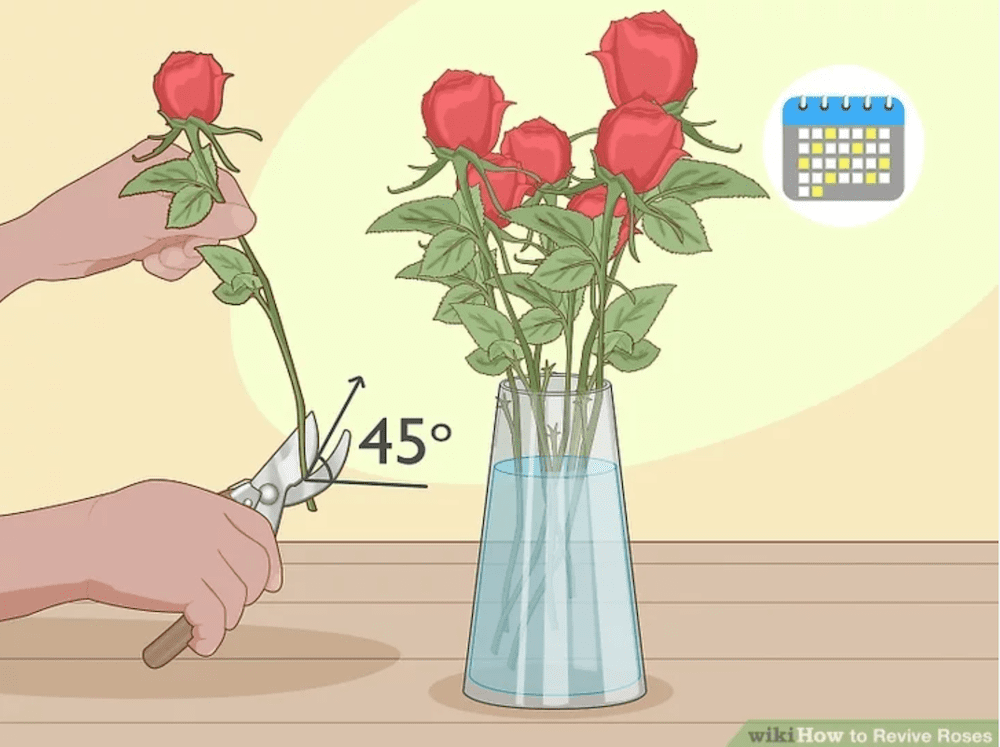
1) Use garden shears to re-cut the ends at a 45-degree angle every 2 days. Fill a bowl with warm water or hold the stems under warm running water as you snip off 1 inch (2.5 cm) from the end of the stem. Cut it at a 45-degree angle to increase the surface area of the stem, allowing the rose to take in more water.
- You don’t have to snip them underwater, but it helps keep air bubbles out of stem and, as a result, increases the amount of water the rose can absorb.
- If the stems are super thick and woody, use a pair of sharp garden shears.
- Avoid using regular scissors or dull blades because they can crush the base of the stem and decrease how much water it can take in.
2) Change out the water every day. Transfer the roses to a clean vase filled with water. Wash the vase in hot, soapy water and rinse it well before refilling it with tap water and replacing the roses. If there is grime or film stuck on the sides of the vase, you may want to soak it with water, vinegar, and baking soda for 1 to 2 hours.
- If your tap water is extra soft, you may want to use distilled water because soft water has higher sodium (which isn’t good for roses).
- To do a soak, fill up the vase with hot water and add 2 tablespoons (29.6 ml) (30 grams) of baking soda and 2 tablespoons (30 mL) of white vinegar. Let it sit for 1 to 2 hours before wiping the inside with a scrub brush or sponge.
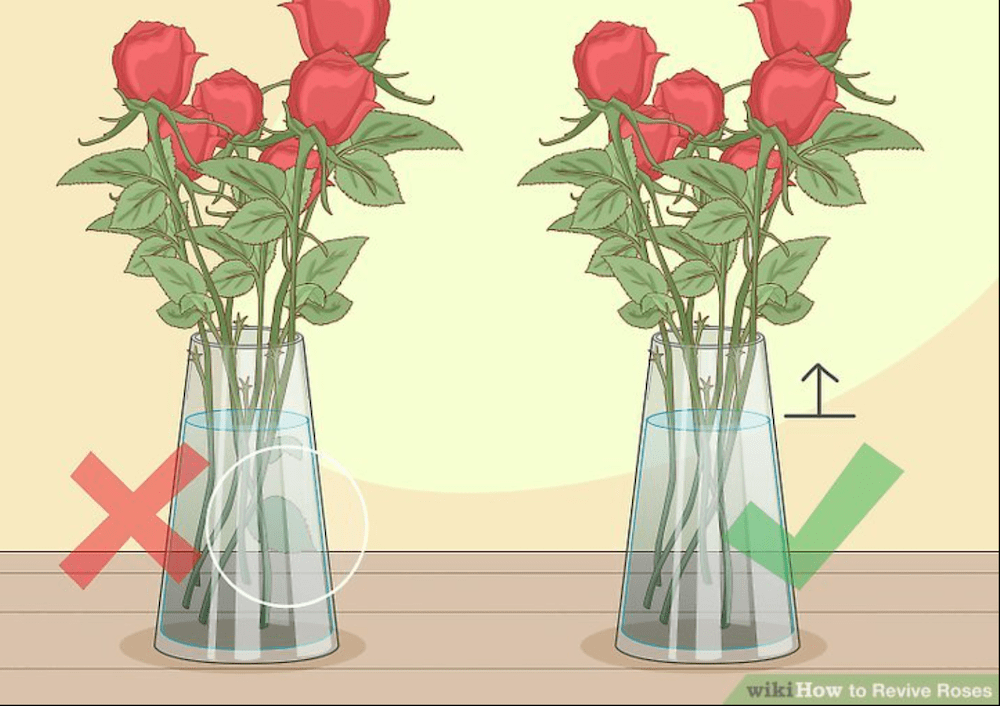
3) Remove any leaves below the waterline. If your roses have leaves near the base of the stem, take those off to ensure they don’t grime up the water with bacteria. Pluck them off with your fingers or use sharp garden shears to clip them off.
- Remove any leaves or petals that may have fallen into the water because they can release bacteria and plug up the stem
4) Add flower food or bleach to kill any bacteria that may be in the water. Sprinkle in the recommended amount of flower food or pour in 1 teaspoon (4.9 mL) of bleach per 16 fluid ounces (470 mL) of water to prevent bacteria from stopping up the stems. If your roses came with a packet of flower food, look at the back of the package to determine how much to use.
- The amount of flower food you should use typically depends on the amount of water in the vase.
- Place an opened packet of flower food in a plastic zipper bag and store it in a cool, dry place
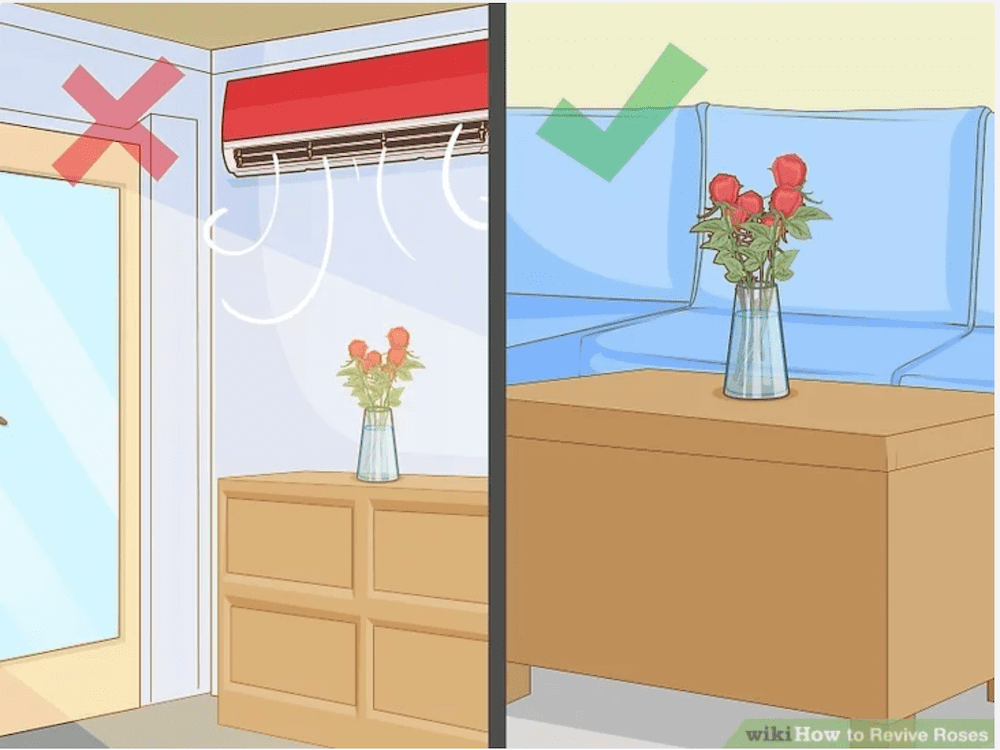
5) Place your roses out of direct sunlight and away from drafts and heat. Put the roses in a spot that is 65°F to 72°F (18°C to 22°C) and gets medium to low indirect light. Keep them away from vents, fans, radiators, televisions, and stoves because drafts and heat will dehydrate the roses.
- If you live in an area with warm days and cool nights, avoid placing your roses where the petals or foliage are touching a window. The hot and cool temperature of the glass can damage the leaves.
- Avoid putting the roses in a place where they’ll be exposed to direct sunlight, like a window sill.
So consider this advice as a way to heal hurting flowers and maintain new ones. However, it is not a panacea. It works for some flowers but not always every rose. (It also is a good method for hydrangeas.) That is what we learn from flowers – to appreciate their beauty and individuality. Some bloom longer than others.
Images: Wikiknows

